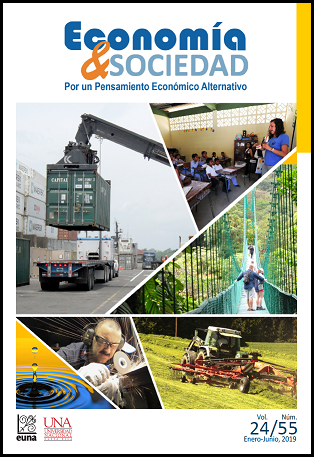Economic growth: convergence and divergence
DOI:
https://doi.org/10.15359/eys.24-55.3Keywords:
Piketty, laws of capitalism, return, wageAbstract
Piketty’s fundamental laws of capitalism in his book “Capital in the Twenty-First Century” (2014) are analyzed to explore the explanatory power of the inequality between average annual rate of return on capital and the rate of growth of production, as a fundamental force for divergence. The author’s r > g crucial assumption and his conclusions are questioned. The convergence-divergence phenomenon is rather believed to be an innate phenomenon of the production and distribution processes. This analysis suggests that the core of inequality may not reside in the elasticity-of-resource-composition, influenced by technological advance. Furthermore, this research will try to contribute to a better understanding of the forces influenced by economic growth and income distribution, which could provide a major contribution to the economic sciences.
References
Arrow, J. K., Chenery, B. H., Minhas, S. B., & Solow, M. R. (1961). Capital-Labor Substitution and Economic Efficiency. The Review of Economics and Statistics, 3(43), 225-250. doi: https://doi.org/10.2307/1927286
Cobb, W. C., & Douglas, H. P. (1928). A Theory of Production. The American Economic Review, 18(1), 139-165. Recuperado de https://www.jstor.org/stable/1811556?origin=JSTOR-pdf&seq=1#page_scan_tab_contents
Domar, E. D. (1946). Capital Expansion, Rate of Growth, and Employment. Econometrica, 2(14), 137-147. doi: https://doi.org/10.2307/1905364
Domar, E. D. (1953). Depreciation, Replacement and Growth. The Economic Journal, 249 (63), 1-32. doi: https://doi.org/10.2307/2226748
Galbraith, J. K. (2014). Kapital for the Twenty-First Century? En Dissent Magazine. Recuperado de https://www.dissentmagazine.org/article/kapital-for-the-twenty-first-century
Goldhammerr, A. (2017). The Piketty Fenomenon. En J. B. Heather Boushey, After Piketty, The Agenda for Economics and Inequality (First ed., 36-59). London, England: Harvard University Press. doi: https://doi.org/10.4159/9780674978195-002
Harrod, R. F. (1939). An Essay in Dynamic Theory. The Economic Journal, 193(49), 14-33. doi: https://doi.org/10.2307/2225181
Harrod, R. F. (1960). Second Essay in Dynamic Theory. The Economic Journal, 278 (70), 277-293. doi: https://doi.org/10.2307/2228728
Krugman, P. (2014). Why we're in a New Gilded Age. En The New York Review of Books. Recuperado de https://www.nybooks.com/articles/2014/05/08/thomas-piketty-new-gilded-age/
Krugman, P. (2 de agosto 2015). The Economics of Inequality by Thomas Piketty. The New York Times. Recuperado de https://www.nytimes.com/2015/08/03/books/review-the-economics-of-inequality-by-thomas-piketty.html
Mankiw, N. G. (2015). Yes, r > g. So What? American Economic Review, 5(105), 43-47. doi: https://doi.org/10.1257/aer.p20151059
Marx, K. (1984). El Capital. La tasa de plusvalor (Tomo I, Volumen I): El proceso de producción del capital (14o ed., 255-269). México: Siglo XXI.
Marx, K. (1986). El Capital. Formación de una tasa general de ganancia (Tasa media de ganancia) y transformación de los valores mercantiles en precios de producción). En Tomo III, Vol. VI: El Proceso global de la producción capitalista (8 va ed., 195-217). México: Siglo XXI.
Naidu, S. (2017). A Political Economy take on W/Y. En H. Boushey, J. B. DeLong, & M. Steinbaum, After Pikety. The Agenda for Economics and Inequality (First ed., 120-154. London, England: Harvard University Press. doi: https://doi.org/10.4159/9780674978195-006
Piketty, T. (2014). Capital in the Twenty-First Century (First ed., 1-685). London: The Belknap Press of Harvard University Press. Doi: https://doi.org/10.4159/9780674369542
Piketty, T. (2017). Toward a Reconciliation between Economics and the Social Sciencies. En H. Boushey, J. B. DeLong, & M. Steinbaum, After Piketty. The Agenda for Economics and Inequality (First ed., 628-860). London, England: Harvard University Press. doi: https://doi.org/10.4159/9780674978195-023
Raval, D. (2017). What’s Wrong with Capital in the Twenty-First Century’s Model? En H. Boushey, J. B. DeLong, & M. Steinbaum, After Piketty. The Agenda for Economics and Inequality (First ed., 86-119). London, England: Harvard University Press. doi: https://doi.org/10.4159/9780674978195-005
Schuessler, J. (2014). Economist Receives Rock Star Treatment. En The New York Times. Recuperado de https://www.nytimes.com/2014/04/19/books/thomas-piketty-tours-us-for-his-new-book.html?_r=0&module=inline.
Solow, M. R. (1956). A Contribution to the Theory of Economic Growth. The Quarterly Journal of Economics, 1(70), 65-94. doi: https://doi.org/10.2307/1884513
Solow, M. R. (1957). Technical Change and the Aggregate Production Function. The Review of Economics and Statistics, 3(39), 312-320. doi: https://doi.org/10.2307/1926047
Solow, M. R. (22 de abril 2014). Thomas Piketty is Right. The New Republic. Recuperado de https://newrepublic.com/article/117429/capital-twenty-first-century-thomas-piketty-reviewed
Stiglitz, J. E. (2015). New Theoretical Perspective on the Distribution of Income and Wealth Among Individuals: Part I. The Wealth Residual. En NBER Working Paper 21189, National Bureau of Economic Research. Recuperado de http://www.nber.org/papers/w21189
Swan, T. (1956). Economic Growth and Capital Accumulation. Economic Record, 2(32), 334-361. Doi: https://doi.org/10.1111/j.1475-4932.1956.tb00434.x
Villalobos, D. (2010). Capital, competencia y ganancia (1era ed.). Heredia: EUNA. Recuperado de https://www.euna.una.ac.cr/index.php/EUNA/catalog/book/110
Downloads
Published
How to Cite
Issue
Section
License
This publication is subject to the Creative Commons License; therefore, its attributions and restrictions must be respected.
Authors publishing in this Journal accept the following conditions:
- Authors retain copyright ownership and give the Journal first publication right of the paper, which is registered with the Creative Commons Attribution-NonCommercial-ShareAlike 4.0 International License. This license allows third parties to use the published work provided it is sourced as firstly published in this Journal.
- Authors may enter into other independent and additional contractual agreements for the non-exclusive distribution of the article published in this Journal (e.g., to be included in an institutional repository or published in a book) provided it is clearly stated that the work was published in this Journal for the first time.
- Authors are allowed and recommended to publish their work on the Internet (for example, on institutional or personal pages) before and during the review and publication process, as it can lead to productive exchanges and a greater and faster dissemination of work published.

The Economía & Sociedad Journal, published by Universidad Nacional, is licensed under a Creative Commons Reconocimiento-NoComercial-CompartirIgual 4.0 Internacional License. Based on http://www.revistas.una.ac.cr/index.php/economia.








